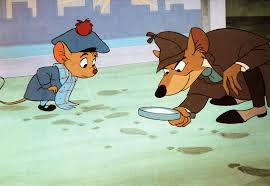 This past week, the world has witnessed Earth based scientist intervention through The Double Asteroid Redirection Test (DART) spacecraft colliding with the asteroid Dimorphos, with the intent to change the asteroid’s orbit. The objective was achieved, in so far as it hit the target.
This past week, the world has witnessed Earth based scientist intervention through The Double Asteroid Redirection Test (DART) spacecraft colliding with the asteroid Dimorphos, with the intent to change the asteroid’s orbit. The objective was achieved, in so far as it hit the target.
The 572kg DART spacecraft collided with the estimated 5bn kg asteroid Dimorphos at 22, 530 km/hr about 11million kms from Earth. The spacecraft hit about 17m from the asteroid’s centre. It will take about two months to find out whether the Dimorphos orbit has been altered as a result of this collision.
Yet at the same time the World has been powerless to counter the growth of hurricanes and just watches, as we did last week, the destruction caused to a number of American cities in Florida in particular.
Then there are earthquakes and volcanic eruptions, all of which we can predict, but unlike eclipses, which we can predict to the minute, natural disasters have a wide variance.
The recently retired climate adviser to President Biden has been reported as saying:
So we’ve worked for the past year with experts at the National Oceanic and Atmospheric Administration, the U.S. Geological Survey and our own Office of Science and Technology Policy to put together the Climate Mapping For Resilience and Adaptation web portal. You can go down to the census tract and look forward. That’s particularly salient, by the way, at a time when under the bipartisan infrastructure law, we’re going to be investing over a trillion dollars in new infrastructure. Let’s make sure that communities know what the risks are and so the infrastructure can be designed in a way that will withstand what we’re seeing in Florida right now.
He uses the word resilience because climate change must be met with continuity of government policy. You can collect all the information but for instance if you are unable to snuff out a nascent hurricane or move its direction so it blows itself out without affecting life or property, then how will we cope with climate change, where more and more the extreme today is the norm of tomorrow.

Meanwhile, there are suggestions to counter hurricanes (typhoons or cyclones) – (a) a set of giant tubes sucking the warm surface water down, or (b) a set of giant wind turbines to guard the shore and in so doing disrupting the hurricane with their vanes. The problem is the number required. One estimate is 78,000 in the Gulf of Mexico. I’m not sure the good burghers of the Florida condominiums would enjoy the view of a turbine forest. But you never know. They could be painted different colours to looking like candy. Yet indicative of the required density, as there are only 15,000 wind turbines in the most populated North Sea, it may resemble a clutter of so many “windmills in your mind” enough to blow the Floridian auricles.
The Lowana Cottage
Nearly 20 years ago, we purchased a beautiful custom-built pole house in Strahan. Strahan had grown as a fishing port located on Macquarie Harbour, a deceptively large stretch of water, with a narrow entrance with dangerous tidal currents called Hell’s Gate. The harbour water is the colour of tea, because of the tannin eluted from button grass which covers the peat bogs. Generally it rains most days of the year on the West Coast, so tannin being washed into the harbour over eons has permanently coloured the water.
However, this is the story about a small, corrugated iron cottage. It was situated on Lowana Road at its eponymous whistle stop location which is, in the local Aboriginal language, the word for “girl”.
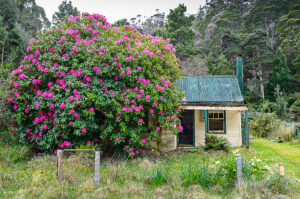 Across the road was the King River, with its sulphur stained stony and sandy shores to a river still contaminated by the tailings from the Mount Lyell mines.
Across the road was the King River, with its sulphur stained stony and sandy shores to a river still contaminated by the tailings from the Mount Lyell mines.
Once a railway ran past the cottage taking ore from Queenstown where the mining operations were transported to Strahan where it was shipped out. On its journey back to Queenstown, the train was back-loaded with coal and coke, stores and equipment and food, as well as providing passenger services for mine employees who elected to commute, while living in the seaside “resort” of Strahan.
The Abt Railway had been constructed to transport the ore across the Rinadeena Saddle, a very challenging climb and therefore on a 3’6” gauge this was a distinct German-patented rack and pinion railway named after the Swiss engineer, Carl Abt, who had added his name because he had improved the original rack and pinion mechanism. The engines had been built and shipped out from Glasgow.
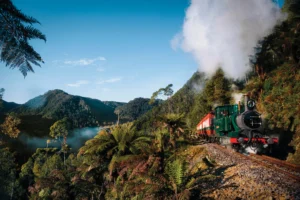
Thus, with its compact green steam engine it would toot as it passed the cottage on its way up to the wharf at Regatta Point where the King River entered the Harbour. At Lowana, there was a crossing with a sign saying to beware of the train. Here there is also a gap in the bush through which the King River could be seen. Over the course of the past 20 years rehabilitation of the shore vegetation has begun, and the reeds and sedge have begun to grow, masking the sulphuric pollution. Yet it is estimated that the River will take hundreds of years to be cleansed.
The cottage would have witnessed the Abt engine hauling the copper ore filled trucks to the port. Meanwhile over the course of the mine operations 100 million tons of copper tailings flowed down the King River
It was a neat cottage. It has stood on its own. People rented it, and a large pink rhododendron grows in the front garden, partially obscuring the front of the cottage. There are camellias round the back of the house. There are clumps of a lily of the valley. Arum lilies intrude along the drive. This exotic patch is framed by man ferns, and the papery melaleuca. Behind the forest thickens with blackwood and unfortunately blackberries have infested the native vegetation.
After 1963, the railway was no more. Transport of ore by rail was rendered uneconomical and the rail was torn up and a road constructed. Thus, when we passed the cottage we would follow a narrow unmade road around the river’s edge until it reached Teepookana, where a steel truss bridge spanned the King River. The red-coloured bridge over the river had fallen into decay by the time we first ventured to Strahan. We were advised not to take any vehicle onto the Bridge, but the view of the river was spectacular there, but there was no way right across unless you wanted to swing on a girder. However, you could still climb on the Teepookana plateau, which we did one day, seeking the Huon pine which was supposed to be growing there. The problem was we climbed up the sandy track through scrub, mostly heath and melaleuca. Eventually, with not a Huon pine in sight, we gave up and went back to the car.
We had gone the wrong way. We should have gone down from the plateau to the river, not up to the ridge. Later we found the clump of pines with their tell-tale bare branches poking up from the distinctive foliage. Much of this pine had been cut down in the century before. The Huon pine still grows in the forest, but in much reduced circumstances. This pine only grows on the West Coast and while the wood is beautiful, the trees themselves are like the dowager duchess, all fronds and gnarled with bare branches betraying old age.
Then after nearly 40 years, the proposal came to reconstruct the railway as a tourist attraction. The road was closed beyond Lowana, and the whole railway was rebuilt from Queenstown to Strahan along the original route. It took four years to rebuild and was re-opened in 2002. Remembering riding on one of the earliest trips, open to the winter cold and rain before the installation of window panes in the carriages, it was quite an experience going back and forth.
The railway has been plagued by maintenance gremlins – need to replace sleepers, the maintenance of the rolling stock, a landslide. Today, the railway is split in two travel sectors. It is now called the Wilderness Railway. The steam train runs from Queenstown only as far as a station called Dubbil Barril; the diesel motor runs from Strahan to Dubbil Barril. But who knows when the line will open again for through travel. Meanwhile, each train turns around.
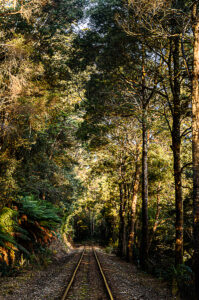 People still live along the line, but the road now ends at Lowana, where the railway line, having replaced the road, vanishes into the rain forest. Further back on the road, there is a house alongside the railway line – and close by where pastures which extend to the edge of hilly tropical forest, where the blackwood take over. Once there was a small herd of belted Galloway cattle with their distinctive magpie colour. Over the years, the animal husbandry has diversified, the Galloways have gone and the acreage, now with its collection of animals, advertises farm stays.
People still live along the line, but the road now ends at Lowana, where the railway line, having replaced the road, vanishes into the rain forest. Further back on the road, there is a house alongside the railway line – and close by where pastures which extend to the edge of hilly tropical forest, where the blackwood take over. Once there was a small herd of belted Galloway cattle with their distinctive magpie colour. Over the years, the animal husbandry has diversified, the Galloways have gone and the acreage, now with its collection of animals, advertises farm stays.
However, the cottage now lies empty. The last inhabitant, a nurse who brought the cottage back to life, has long gone and no one has lived there since. The front door is off its hinges; and all the window panes have been broken. Now, the bush is slowly encroaching on the once carefully-tended garden of the once equally well-cared for cottage, but it is Spring and the rhododendron and camellias are in full flower. But for how long. Will they remain defiant against the encroaching forest?
The Old Man and The Key
From the time I read The Old Man and the Sea I have always been a fan of Ernest Hemingway. Over the years, I have tracked Hemingway in a sort of a way. Maybe we both liked the same places. I know that in the suburb of Oak Park in Illinois, where he was born in 1899, I tripped on the broken pavement and left my facial imprint on the grass verge. Parenthetically, Oak Park has the highest concentration of Frank Lloyd Wright buildings, some of which were either recently constructed or were built at the time of Hemingway’s birth. Frank Lloyd Wright architecture has always been another of our interests as in general has been the Chicago School, which also spawned Walter Burley Griffin (but not his creative spouse and avatar, Marion Mahony).
However, over the past few years my attention had been diverted from my episodic Hemingway Trail.
My memory of Hemingway was rekindled by a recent article in NYT. Key West was one of the places where Hemingway lived for a time. In fact, the house still retained the Hemingway association through the persistence of his six toed cats. I remember they were everywhere when we visited Key West some years ago.
Following the Hemingway Trail can also involve a Bar crawl, and the particular Hemingway watering spot in Key West was Sloppy Joes, owned by Betty and Telly Otto Bruce, and known to his friends as Toby. Toby Bruce was part of Hemingway’s inner circle, not only as his right-hand man, also sometime chauffeur and as a competent mechanic. One would expect that Hemingway, the bar fly, would not leave his mark without a signature drink – in this case it was a daiquiri concocted by Toby.
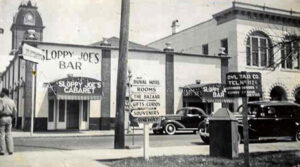
However, the gist of the NYT article was that in 1939, after his second marriage crumbled, Hemingway left his belongings in the storeroom of Sloppy Joe’s. He never returned to collect them. As the NYT reported: after Hemingway’s death, his fourth wife, Mary Hemingway, went through the material, packed up what she wanted, and gave the rest to the Bruces.
This trove then spent decades uncatalogued in cardboard boxes and ammunition storage containers, surviving both hurricanes and floods.
Eventually, Betty and Toby’s son, Benjamin “Dink” Bruce and a local historian, Brewster Chamberlin, began creating an inventory of the haul in consultation with the Hemingway scholar Sandra Spanier, who rejoices in the title of The Pennsylvania State University, University Park General Editor, The Hemingway Letters Project.
It was here, amid bullfighting tickets, cheques, newspaper clippings and letters from his lawyer, family members and friends like the writer John Dos Passos and artists Joan Miró and Waldo Peirce, (whose portrait of Hemingway appeared on a 1937 cover of Time) that they discovered a stained brown notebook. Inside was Hemingway’s first known short story, about a fictional trip to Ireland, written when he was 10 years old.
I was tempted to say – so what? What is it about Hemingway that fascinates. This was a man who wrestled with his demons before eventually shooting himself with a double barrelled shotgun. Hardly the death of the Hero, with brain and bone fragments splattered across the room. Left unrecognisable in death at 61 years.
I stood at the bollard at the end of Key West gazing out over the Caribbean, facing a fiery vermillion sunset. So, confronting its belligerent beauty thinking that Cuba was just across the horizon where The Old Man fished. I hoped then to see Cuba one day. This I did a decade later, but I never saw The Old Man.
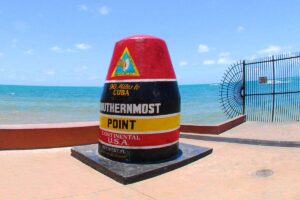
Waratahs
My favourite flower is the State emblem of NSW, the waratah (Telopea speciosissima). The waratahs, with the distinctive florets is only available in limited amounts as a cut stem in October. Generally red, white waratahs sometimes appear on the market. Each stem is not cheap, but with appropriate handling they might last two weeks in a vase. Sadly, every time we have tried to grow them in the garden, we have been unsuccessful
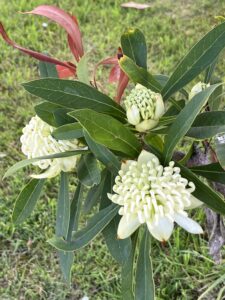
In Tasmania, we had noted at various times along the Murchison Highway or on the Belvoir road west of the Cradle Mountain turnoff, clumps of the Tasmanian waratahs, (Telopea truncata). They are more of a bush with less florets than their NSW cousins. Normally, we do not come to Tasmania in early Spring, but three years ago we decided to plant some Tasmanian waratahs at Strahan – they died, probably not enough water and not enough TLC given the plants were little more than seedlings.
We then bought a number of more mature plants, which were hybrids. They were much more robust and are thriving. However, when you drive around Strahan at this time of the year, the Tasmanian waratahs are no longer shrubs, they are more trees smothered as they are in Tasmanian waratahs.
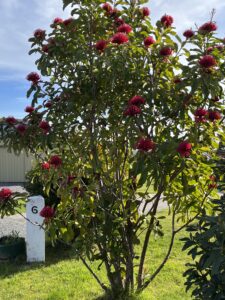
They are a wonderful sight and it took years before we recognised the addresses where the telopea are located because, when they stop flowering, they become just background lush green foliage. And I must admit until relatively recently I had never thought of waratahs being part of the Strahan streetscape. There had been none on our property, but there now are. It changes the perspective.
You wonder whether there is another industry for this town. After all, Tasmania is famous for its flowers – lavender, tulips, and not forgetting the delicate mauve of the opium poppy flower. Why not a market in Waratahs of the telopea truncata persuasion?
Mouse Whisper
Have you ever thought of this?
Newspapers are dispensing with cartoons and very few have cartoon mice depicted as heroes unlike films. In fact, newspapers have never been partial to mice cartoons.
In contrast, in films mice are almost always portrayed in a positive light, as opposed to cats that are very often antagonistic and villainous. As I was reminded, we have Mickey Mouse, Minnie Mouse, Pixie and Dixie, Jerry from Tom and Jerry, Speedy Gonzales (and Slowpoke Rodriguez), Mighty Mouse, Danger Mouse, and the Great Mouse Detective to name only a few of the characters.
